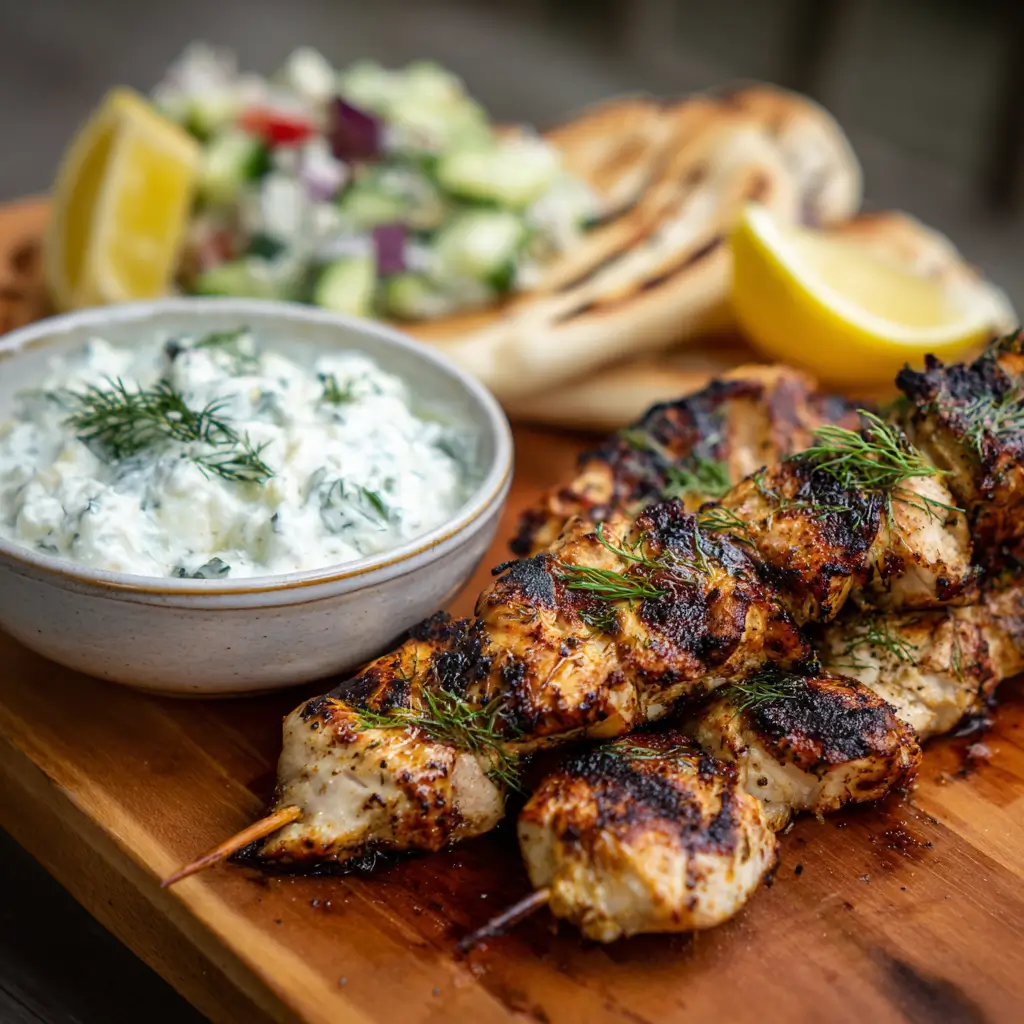Grilled Chicken Souvlaki with Tzatziki: A Taste of Greece in Every Bite
There’s something undeniably magical about the aroma of chicken sizzling on the grill, infused with the bold flavors of lemon, garlic, and oregano—classic elements of Greek cuisine. Grilled Chicken Souvlaki with Tzatziki is more than just a meal; it’s a culinary journey to the sun-drenched coasts of the Mediterranean. Whether you’re hosting a summer barbecue, preparing a weeknight dinner, or simply craving something fresh and satisfying, this dish delivers vibrant taste, tender texture, and wholesome ingredients that delight the senses. Paired with creamy, cool tzatziki sauce, every bite balances tangy, savory, and herbal notes perfectly.
The History of Souvlaki: A Culinary Legacy
Souvlaki traces its roots back thousands of years to ancient Greece. Archaeological evidence suggests that skewered and grilled meats were consumed as early as the Bronze Age, with Homer’s Iliad even referencing meat roasted on spits. The word “souvlaki” itself comes from the modern Greek word “souvla,” meaning “skewer” (from the Latin *subula*). Traditionally, souvlaki consisted of small pieces of pork or lamb marinated in wine and herbs, then grilled over open flames. Over time, regional variations emerged across Greece and Cyprus, with chicken becoming a popular alternative due to its lean profile and widespread availability.
In the 20th century, souvlaki evolved into a beloved street food staple. Served in pita bread with tomatoes, onions, and tzatziki, it became synonymous with fast, flavorful, and satisfying meals. Today, souvlaki has gained international acclaim and is enjoyed worldwide, often customized with local tastes while preserving its authentic Hellenic soul. The addition of tzatziki—a refreshing yogurt-based sauce with cucumber and garlic—complements the smoky grilled meat, creating a harmony of textures and temperatures that defines the dish.
Ingredients Breakdown: Fresh, Flavorful, and Wholesome
The magic of Grilled Chicken Souvlaki lies not only in its preparation but also in the quality and balance of its ingredients. Each component plays a vital role in building layers of flavor, moisture, and aroma.
For the Chicken Souvlaki:
- Chicken Breast or Thighs: Boneless, skinless chicken breasts are commonly used for their lean texture, though thighs offer more juiciness and richness due to higher fat content.
- Olive Oil: High-quality extra virgin olive oil adds richness and helps carry the marinade’s flavors while preventing sticking on the grill.
- Lemon Juice: Freshly squeezed lemon juice provides brightness and acidity, essential for tenderizing the chicken and enhancing other seasonings.
- Garlic: Minced or grated garlic brings pungent depth and an unmistakable aromatic presence central to Mediterranean cooking.
- Dried Oregano: A quintessential Greek herb, oregano contributes earthy, slightly floral notes that define the dish’s character.
- Paprika: Adds mild sweetness and a subtle warmth, along with a golden hue to the marinade.
- Salt and Black Pepper: Essential seasoners that enhance all other flavors and create a balanced taste profile.
- Onion Powder and Dried Mint (optional): These add complexity and authenticity, with mint offering a refreshing undertone often found in traditional recipes.
For the Tzatziki Sauce:
- Greek Yogurt: Thick, creamy, and rich in protein, full-fat Greek yogurt forms the base and gives the sauce its luxurious texture.
- Cucumber: Peeled, seeded, and finely grated or diced, cucumber adds coolness and crunch. Salting and draining it beforehand removes excess moisture, preventing a watery sauce.
- Garlic: Raw garlic is key for sharpness and zing—adjust according to preference.
- Lemon Juice: Brightens the sauce and balances the richness of the yogurt.
- Fresh Dill: Chopped dill imparts a grassy, slightly sweet note that complements both chicken and cucumber.
- Olive Oil: Drizzled into the mixture for smoothness and enhanced mouthfeel.
- Vinegar (white or red wine): Optional, for added tang and preservation.
- Salt and Pepper: To season and round out the flavors.
Optional Serving Components:
- Fresh pita bread or warm flatbreads
- Sliced tomatoes, red onions, and lettuce
- Kalamata olives
- Feta cheese crumbles
- Lemon wedges for serving
- Grilled vegetables (bell peppers, zucchini)
Step-by-Step Recipe: How to Make Perfect Grilled Chicken Souvlaki with Tzatziki
Step 1: Prepare the Marinade
- In a medium bowl, whisk together 1/3 cup of extra virgin olive oil, juice of 1 large lemon (about 1/4 cup), 4 cloves of minced garlic, 1 tablespoon dried oregano, 1 teaspoon paprika, 1 teaspoon salt, 1/2 teaspoon black pepper, 1/2 teaspoon onion powder, and 1/4 teaspoon dried mint (if using).
- Taste and adjust seasoning if needed—remember that the flavors will mellow slightly during marination.
Step 2: Marinate the Chicken
- Cut 2 pounds (about 900g) of boneless, skinless chicken breasts or thighs into 1.5-inch cubes. Try to keep them uniform for even cooking.
- Place chicken in a resealable plastic bag or shallow glass dish. Pour marinade over the chicken, ensuring all pieces are well-coated.
- Seal or cover and refrigerate for at least 2 hours, preferably 4–6 hours. For best results, marinate overnight (up to 12 hours). Do not exceed 24 hours, as the acid can start to break down the proteins too much, leading to mushiness.
Step 3: Make the Tzatziki Sauce
- Peel 1 medium cucumber, cut it in half lengthwise, and scoop out the seeds using a spoon.
- Grate the cucumber using a box grater or finely dice it. Place the grated cucumber in a clean kitchen towel or cheesecloth and squeeze firmly to remove as much liquid as possible. This step is crucial for a thick, creamy tzatziki.
- In a mixing bowl, combine 2 cups of full-fat Greek yogurt, the drained cucumber, 2 minced garlic cloves, 1 tablespoon freshly squeezed lemon juice, 1 tablespoon chopped fresh dill, 1 tablespoon extra virgin olive oil, 1/2 teaspoon salt, and freshly ground black pepper to taste.
- Stir until smooth and well blended. Cover and refrigerate for at least 1 hour before serving to allow flavors to meld. Tzatziki tastes best when chilled and can be made up to 2 days ahead.
Step 4: Soak the Skewers (If Using Wooden Ones)
- If using wooden or bamboo skewers, soak them in water for at least 30 minutes prior to grilling to prevent burning.
- Metal skewers do not require soaking and conduct heat better, promoting even cooking.
Step 5: Thread the Chicken onto Skewers
- Remove chicken from the marinade (discard leftover marinade unless boiled for safety).
- Alternate threading chicken pieces onto skewers, leaving a small space between each cube for even heat circulation.
- For a colorful presentation, thread chunks of red bell pepper, red onion, or cherry tomatoes between chicken pieces.
Step 6: Preheat and Grill the Souvlaki
- Preheat your grill to medium-high heat (around 375°F–400°F / 190°C–200°C). Clean and oil the grates to prevent sticking.
- Place skewers on the grill and cook for 3–4 minutes per side, turning once halfway through. Total cooking time should be 8–12 minutes, depending on the size of the chicken pieces.
- Cook until the internal temperature reaches 165°F (74°C) and the outside is nicely charred with grill marks.
- Remove from heat and let rest for 3–5 minutes to retain juices.
Step 7: Serve and Enjoy
- Serve hot off the grill with tzatziki sauce on the side or generously drizzled over the top.
- Offer warm pita bread, a Greek salad, or grilled vegetables as accompaniments.
- For a complete wrap, place a skewer inside a pita, add sliced veggies, crumbled feta, and a generous dollop of tzatziki, then fold and enjoy.
Tips for Success: Elevating Your Souvlaki Game
- Use high-quality olive oil: Since it’s a dominant flavor, choose a good extra virgin olive oil with a fruity, peppery finish.
- Don’t skip the marinating time: At least 2 hours is ideal, but longer marination equals deeper flavor penetration and more tender chicken.
- Avoid overcrowding the skewers: Leave a little space between chicken cubes to ensure proper browning and thorough cooking.
- Control grill heat: Too high, and the outside burns before the inside cooks; too low, and you lose that desirable sear. Medium-high is perfect.
- Rest the chicken: Letting it sit after grilling allows juices to redistribute, resulting in moister meat.
- Squeeze the cucumber thoroughly: Excess water is the enemy of thick tzatziki. Take the time to drain it well.
- Add freshness with herbs: Beyond dill, consider adding a pinch of fresh mint or parsley to the tzatziki for extra dimension.
- Double the tzatziki: It keeps well and tastes even better the next day—plus, it’s great as a dip, sandwich spread, or salad dressing.
- Grill the pitas: Lightly toast your pita bread on the grill for warmth and a smoky flavor that enhances the overall experience.
Variations and Customizations: Make It Your Own
While traditional Grilled Chicken Souvlaki remains a favorite, there are countless ways to personalize this dish based on dietary needs, preferences, or available ingredients.
- Protein Swaps: Replace chicken with pork shoulder, lamb, shrimp, or even halloumi cheese for a vegetarian twist. Shrimp souvlaki cooks faster (2–3 minutes per side), so monitor closely.
- Marinade Variations: Add a splash of red wine vinegar, a teaspoon of honey for balance, or a pinch of cumin for a Middle Eastern flair.
- Gluten-Free Option: Serve over a bed of quinoa, rice, or a Mediterranean grain salad instead of pita.
- Dairy-Free Tzatziki: Use coconut yogurt or cashew-based alternatives and omit feta. Add a bit of nutritional yeast for a cheesy hint.
- Vegan Version: Marinate and grill firm tofu, tempeh, or portobello mushrooms. Use plant-based yogurt for tzatziki.
- Spicy Kick: Add crushed red pepper flakes or a dash of hot sauce to the marinade or tzatziki for heat lovers.
- Herb Infusions: Experiment with fresh rosemary, thyme, or marjoram in the marinade for unique aromatic profiles.
- Meal Prep Friendly: Assemble skewers ahead of time and freeze them (without vegetables) for quick weeknight grilling.
- Kofta-Style: Instead of cubed chicken, mix ground chicken with the marinade ingredients and shape around skewers like sausage for a different texture.
Health Considerations and Nutritional Value
Grilled Chicken Souvlaki with Tzatziki is not only delicious but also a nutritious choice when prepared with mindful ingredients.
Nutritional Highlights (per serving, approx. 3 oz chicken + 1/4 cup tzatziki + 1 pita):
- Calories: ~400–450 kcal
- Protein: 30–35g – supports muscle repair and satiety
- Fat: 15–18g – primarily heart-healthy monounsaturated fats from olive oil and yogurt
- Carbohydrates: 35–40g – mostly complex carbs from whole wheat pita and vegetables
- Fiber: 4–6g – promotes digestive health
- Vitamins & Minerals: Rich in vitamin C (lemon, tomatoes), calcium (yogurt, feta), iron (chicken), and potassium (cucumber, tomato)
Health Benefits:
- Lean Protein Source: Chicken breast is low in saturated fat and high in essential amino acids.
- Probiotics: Greek yogurt contains beneficial bacteria that support gut health.
- Antioxidants: Garlic, oregano, and olive oil are rich in antioxidants linked to reduced inflammation and improved cardiovascular health.
- No Refined Sugars: When made from scratch, this dish avoids processed sugars common in store-bought sauces.
- Balanced Meal: Combines protein, healthy fats, fiber-rich carbs, and fresh produce for sustained energy.
Dietary Notes:
- Low Carb/Keto: Skip the pita and serve over cauliflower rice or a green salad.
- High-Protein Diet: Increase chicken portion or add extra tzatziki for more protein.
- Lactose Sensitivity: Use lactose-free yogurt or dairy-free alternatives in tzatziki.
- Sodium Control: Reduce added salt or use low-sodium yogurt and avoid salty feta.
Full Ingredient List
Chicken Souvlaki (Serves 4–6):
- 2 lbs (900g) boneless, skinless chicken breasts or thighs, cubed
- 1/3 cup extra virgin olive oil
- Juice of 1 large lemon (approx. 1/4 cup)
- 4 cloves garlic, minced
- 1 tbsp dried oregano
- 1 tsp paprika
- 1 tsp salt
- 1/2 tsp black pepper
- 1/2 tsp onion powder (optional)
- 1/4 tsp dried mint (optional)
- Wooden or metal skewers
- Vegetables for skewering (red bell pepper, red onion, cherry tomatoes)
Tzatziki Sauce (Makes ~2 cups):
- 2 cups full-fat Greek yogurt
- 1 medium cucumber, peeled, seeded, and grated
- 2 cloves garlic, minced
- 1 tbsp fresh lemon juice
- 1 tbsp chopped fresh dill
- 1 tbsp extra virgin olive oil
- 1/2 tsp salt
- Freshly ground black pepper, to taste
- 1 tsp white wine vinegar (optional)
Detailed Directions
- Marinate the Chicken: In a bowl, whisk olive oil, lemon juice, garlic, oregano, paprika, salt, pepper, onion powder, and mint. Add chicken cubes and coat thoroughly. Transfer to a sealed container or zip-top bag and refrigerate for 2–12 hours.
- Prepare Tzatziki: Grate cucumber and drain in a towel. In a bowl, mix yogurt, drained cucumber, garlic, lemon juice, dill, olive oil, salt, pepper, and vinegar (if using). Chill for at least 1 hour.
- Soak Skewers: If using wooden ones, submerge in water for 30+ minutes.
- Assemble Skewers: Remove chicken from marinade. Alternate threading chicken with vegetables onto skewers.
- Preheat Grill: Heat to medium-high (375°–400°F). Oil grates.
- Grill Souvlaki: Cook skewers 3–4 minutes per side until internal temp reaches 165°F. Rest 5 minutes.
- Serve: Plate with tzatziki, warm pitas, fresh veggies, and optional feta. Drizzle with olive oil or lemon juice if desired.
Frequently Asked Questions (FAQ)
Can I bake souvlaki instead of grilling?
Yes! Preheat oven to 400°F (200°C). Place skewers on a lined baking sheet and bake for 15–20 minutes, flipping halfway, until cooked through. Broil for 2–3 minutes at the end for char.
How long does tzatziki last in the fridge?
Up to 4 days in an airtight container. The flavor deepens over time, but separation may occur—just stir before serving.
Can I freeze souvlaki?
Cooked souvlaki can be frozen for up to 3 months. Thaw in the fridge and reheat gently in the oven or skillet. Marinated raw skewers (without veggies) can also be frozen—thaw completely before grilling.
Why is my tzatziki watery?
Likely due to insufficient cucumber draining. Always squeeze tightly in a cloth. You can also add a tablespoon of mayonnaise or sour cream to thicken if needed.
Is souvlaki gluten-free?
The chicken and marinade are naturally gluten-free, but check labels on spices and serve without pita or with certified GF bread.
Can I use regular yogurt instead of Greek?
Greek yogurt is thicker and less acidic. Regular yogurt will make tzatziki runny. If using, strain it in a cheesecloth-lined sieve for 1–2 hours first.
What sides go well with souvlaki?
Greek salad, lemon potatoes, hummus, grilled vegetables, rice pilaf, or a simple arugula and tomato salad.
Can I make this in advance?
Absolutely! Marinate chicken, prepare tzatziki, and prep veggies 1–2 days ahead. Assemble skewers the night before for stress-free grilling.
Summary
Grilled Chicken Souvlaki with Tzatziki is a vibrant, healthy, and deeply flavorful dish rooted in Greek tradition, featuring tender marinated chicken grilled to perfection and served with a cool, creamy cucumber-yogurt sauce. Easy to customize and perfect for gatherings or meal prep, it brings the taste of the Mediterranean straight to your table.










